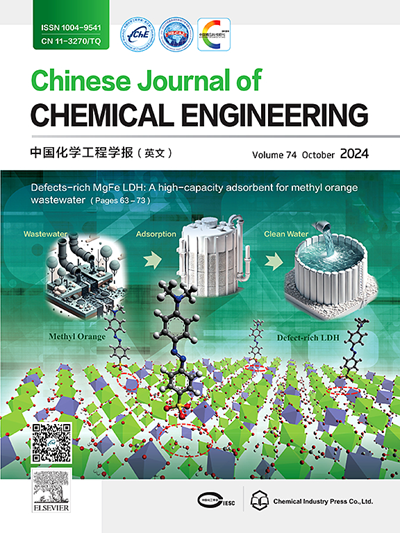生物质衍生的氮掺杂多孔碳作为增强电容去离子的可持续流动电极材料
IF 3.7
3区 工程技术
Q2 ENGINEERING, CHEMICAL
引用次数: 0
摘要
淡水短缺已成为一个严重的全球环境挑战。流动电极电容去离子(FCDI)是一种很有前途的实现高效低能海水淡化的技术。本研究提出了一种新型流动电极材料,氮掺杂多孔碳(NPC),该材料来源于生物质,具有成本效益和高性能。NPC材料是由豆壳经高温预碳化和KHCO3活化合成的,具有丰富的多孔结构、增加的比表面积和高石墨化程度,与活性炭(AC)相比,具有优越的电容性能。海水淡化实验表明,NPC流动电极的fdi性能优于交流流动电极。在电压为2.5 V时,在6 g·L−1 NaCl溶液中,NPC系统的平均脱盐率为104.9 μg·cm−2·min−1,充电效率(CE)为94.0%,能耗(EC)仅为4.4 kJ·g−1。此外,基于npc的FCDI系统表现出值得称赞的脱盐循环稳定性,在长时间连续脱盐循环后保持相对稳定的能耗和效率。这项研究对大规模应用的环保、低成本、高性能FCDI系统的发展具有重要意义。本文章由计算机程序翻译,如有差异,请以英文原文为准。

Biomass-derived nitrogen-doped porous carbon as a sustainable flow-electrode material for enhanced capacitive deionization
Freshwater scarcity has emerged as a critical global environmental challenge. Flow-electrode capacitive deionization (FCDI) represents a promising technology for achieving efficient and low-energy seawater desalination. This study presents a novel flow-electrode material, nitrogen-doped porous carbon (NPC), which is derived from biomass and demonstrates both cost-effectiveness and high performance. The NPC material is synthesized from bean shells through high-temperature pre-carbonization followed by activation with KHCO3, resulting in a rich porous structure, increased specific surface area, and high graphitization degree, which collectively confer superior capacitance performance compared to activated carbon (AC). Desalination experiments indicate that the FCDI performance of the NPC flow-electrode surpasses that of the AC flow-electrode. Specifically, at a voltage of 2.5 V in a 6 g·L−1 NaCl solution, the NPC system achieves an average salt removal rate (ASRR) of 104.9 μg·cm−2·min−1, with a charge efficiency (CE) of 94.0% and an energy consumption (EC) of only 4.4 kJ·g−1. Furthermore, the NPC-based FCDI system exhibits commendable desalination cycling stability, maintaining relatively stable energy consumption and efficiency after prolonged continuous desalination cycles. This research holds significant implications for the advancement of environmentally friendly, low-cost, high-performance FCDI systems for large-scale applications.
求助全文
通过发布文献求助,成功后即可免费获取论文全文。
去求助
来源期刊

Chinese Journal of Chemical Engineering
工程技术-工程:化工
CiteScore
6.60
自引率
5.30%
发文量
4309
审稿时长
31 days
期刊介绍:
The Chinese Journal of Chemical Engineering (Monthly, started in 1982) is the official journal of the Chemical Industry and Engineering Society of China and published by the Chemical Industry Press Co. Ltd. The aim of the journal is to develop the international exchange of scientific and technical information in the field of chemical engineering. It publishes original research papers that cover the major advancements and achievements in chemical engineering in China as well as some articles from overseas contributors.
The topics of journal include chemical engineering, chemical technology, biochemical engineering, energy and environmental engineering and other relevant fields. Papers are published on the basis of their relevance to theoretical research, practical application or potential uses in the industry as Research Papers, Communications, Reviews and Perspectives. Prominent domestic and overseas chemical experts and scholars have been invited to form an International Advisory Board and the Editorial Committee. It enjoys recognition among Chinese academia and industry as a reliable source of information of what is going on in chemical engineering research, both domestic and abroad.
 求助内容:
求助内容: 应助结果提醒方式:
应助结果提醒方式:


